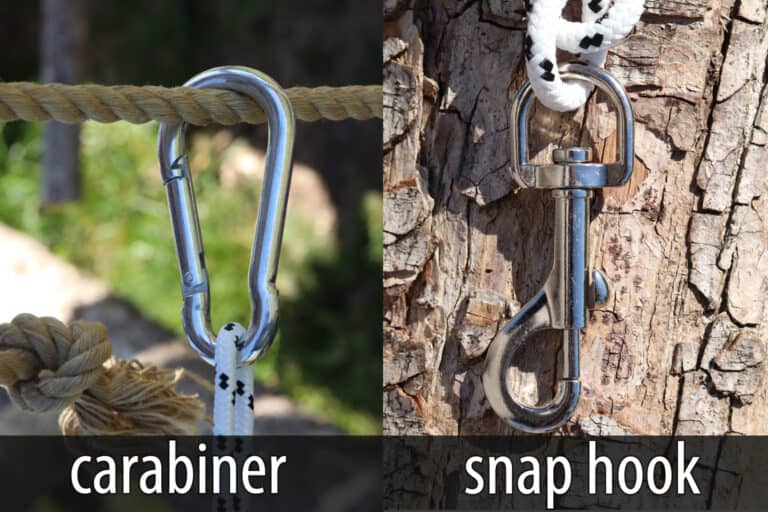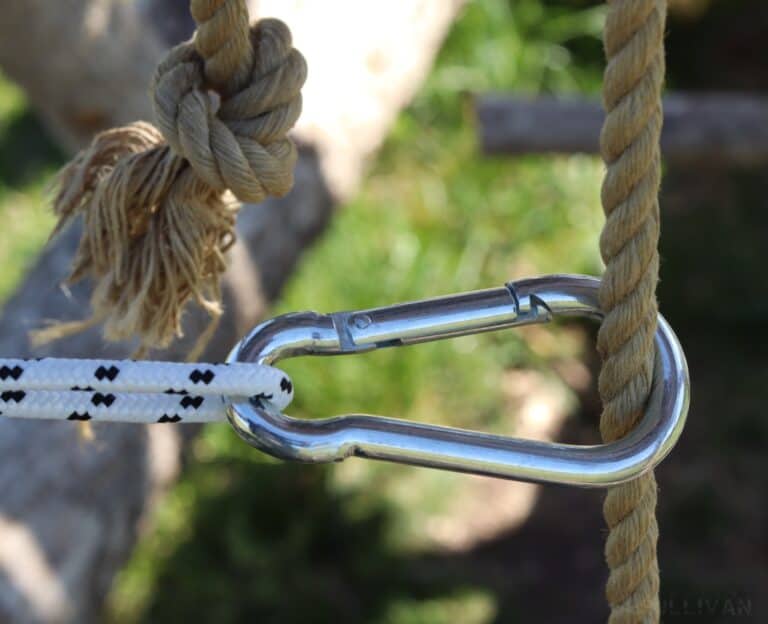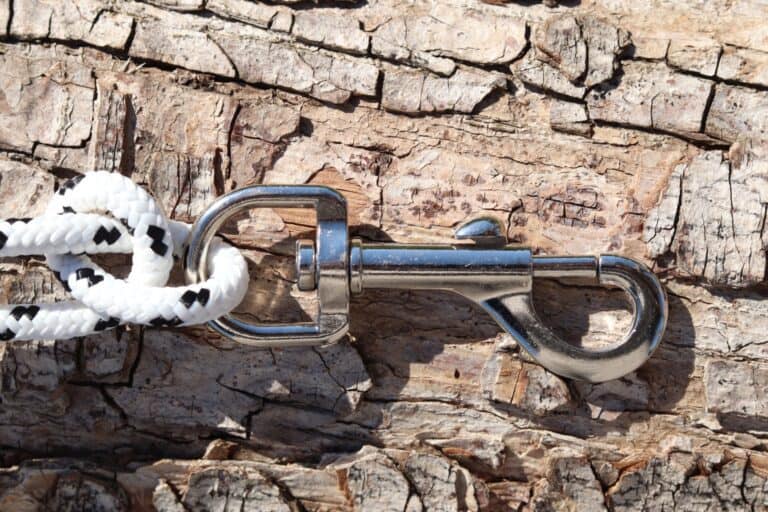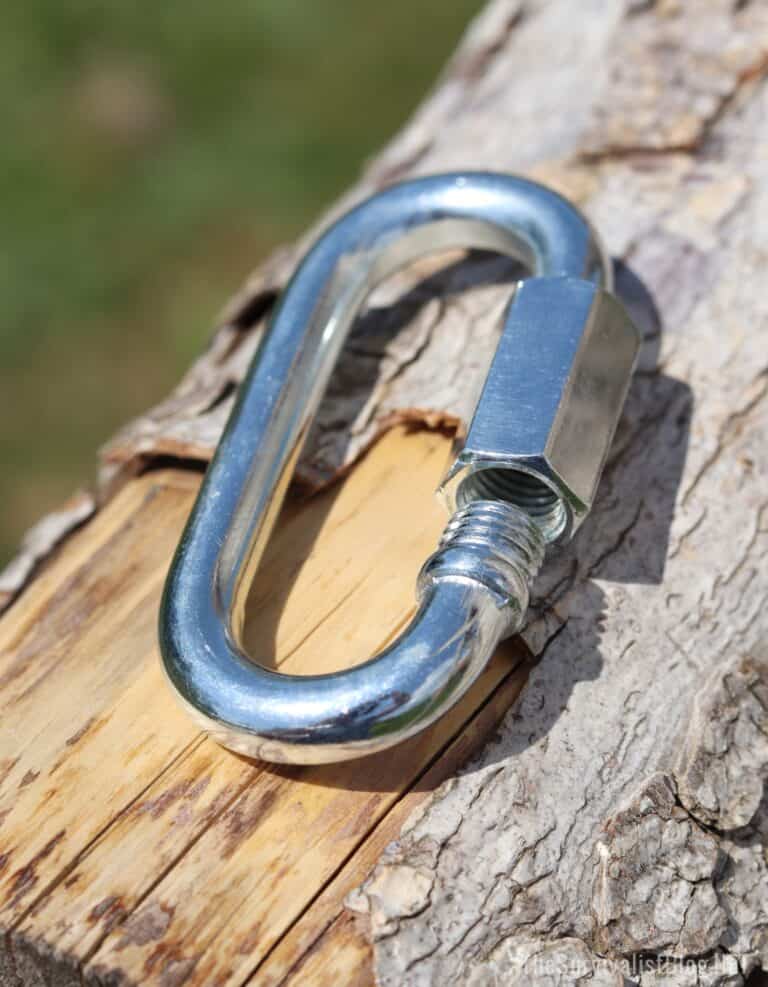The carabiner and snap hook are both hooks with a safety mechanism to stop them from opening. The carabiner comes from the German Karibinerhaken, relating to the carbine – a rifle with a shortened barrel used from the 19230’s onwards.
The clip was used to fasten the gun to a strap for carrying and be quickly released when the weapon needed to be used.

These days the carabiner is being used in climbing, rescue, and other activities that require a dependable and safe quick-release system. But what about the snap hook – isn’t it almost the same?
So what’s the difference between a carabiner and a snap hook?
Carabiners release with pressure inwards, while snap hooks release with downwards pressure, even though they both have spring-loaded gates. Carabiners are used for professional climbing equipment, while snap hooks have a variety of household and boating uses.
Materials snap hooks can be made from include:
- Die cast zinc
- Stainless steel
- Brass malleable iron
- Steel
- Aluminum
- Plastic
Material professional carabiners are made from include:
- Aluminium alloy – light and strong
- Stainless steel – super strong but heavier
Safety of Snap Hooks and Carabiners
To release a carabiner one pushes the gate inwards towards the spine of the carabiner. The snap hook gate is released downwards when you apply thumb pressure on a small knob pressing away from the top of the hook.
Both gate mechanisms are spring loaded, meaning that once pressure on the gate is released it will automatically close. The snap shackle releases easily under tension, but the carabiner will only release once tension is overcome.
Some snap hooks have a swivel, and some carabiners have a threaded locking sleeve that will prevent them being accidentally released.
Both snap hooks and carabiners have the ability to bear weight, and for professional use need to be tested and rated with a kN (kilo Newton) rating etched onto the spine of the hook, to ensure they can support the load.
This is a carabiner:

… and this is one type of snap hook:

Ratings for Carabiners
Folks who may need to secure heavy weights, use climbing equipment, or create pulley systems, will use carabiners that have been properly rated.
The OSHA (Occupational Health and Safety Act) final rule which came into effect in 2017 specifies that the gate strength of carabiners needs to be tested in “all directions” to a 16 kN or 3600 lb load in order to comply with the industry Walking-Working Surfaces and Personal Protective Equipment (Fall Protection Systems) Standards (29 CFR part 1910, subparts D and I).
That was quite a mouthful of industry speak, but climbers and people working at height know their lives depend on their equipment. Carabiners are part of the equipment used by first responders to keep themselves secure and get victims to safety.
Now in the paragraph above it was only the gate that was mentioned, the actual tensile load for the carabiner is 5000lb or 22.5kN.
On a cautionary note carabiners are not meant for use by people who weigh more than 420lb.
The kN force is calculated by taking the weight of a person and multiplying by the acceleration of the fall. We’re not going into details in this article, but if you are interested in the calculations you’ll find information here.
Carabiners and Snap Hooks are Often Confused
Unfortunately there are many advertisers for non-professional use carabiners who do not seem to distinguish between a snap hook and a carabiner or else tout their products as a snap-hook carabiner.
If you look up photos of snap hooks you’ll find pictures of carabiners and vice versa.
Carabiners and snap hooks meant for heavy duty use have the kN rating etched into the spine of the hook. If you need carabiners for survival use buy them from a company that supplies climbing equipment and that employs experts who can help you.
What Not to Do with Carabiners and Snap Hooks
There are a few don’t relating to carabiners and snap hooks if you want to stay safe in survival situations
Don’t:
- ❌ Attach a snap hook to a carabiner
- ❌ Attach one carabiner to another
- ❌ Attach a carabiner directly to webbing
- ❌ Use a snap hook for climbing
- ❌ Buy a carabiner or heavy duty snap hook without a kN rating on it
Different Types of Snap Hooks
Panic Snap
If you work around horses you’ll be familiar with the panic-snap quick release.
There is no need to press down on the knob on the side – when horses start panicking you need to get them free of encumbrances easily, so a pull down on the panic snap in the direction of the arrow on the snap hook will ensure a quick one-handed release.
This type of snap hook can be used to release horses to get them away from danger within seconds, or to clip on their blankets, water or feed buckets.
Fixed eye snap
The base of the snap hook is fixed in place, and does not swivel. This type of hook is used in the marine industry for attaching boating equipment, for example attached to trailer safety chains, boat anchor chains, or attaching a bailing bucket to the boat
Cast snap hooks
These are used for fishing and it saves tying and attaching a line to different rigs. Want to change the lure, or hooks – just snap on a new system using the stainless-steel cast snap-hook. It saves fishermen loads of time.
Swivel snaps
The swivel snap hook is often used for dog leads, camera straps, and prevents the webbing getting tangled. The base is adjustable meaning the spring can turn along the vertical axis.
Trigger snap
So named, because it requires a pull-back action like that of a gun, the trigger snap is way easier than the knob that pushes the gate downward with pressure from the thumb as in the bolt type snap hook.
The trigger snap allows for line to be released with one hand. This makes it as easy to use as a carabiner for quick one-handed releases. The trigger snap cannot be accidentally released and can be used for binocular straps, camera, purse and handbag straps.
Bolt Snaps
These are most often seen on pet leads, and employ pressure on a button on the side of the gate in order to slide it down to open.
Different Shapes of Carabiners
The different types will be dependent on the carabiner’s shape, gate type and the size and strength of the carabiner.
D Shape
This is the strongest of the carabiner shapes and is used for the majority of climbing applications. Loads are distributed towards the spine, away from the gated side, due to the shape.
Off set D
The asymmetrical D shape is a popular one, being smaller at one end of the D and with a larger gate opening. This makes clipping them very easy. However, the interior area is not at large as the conventional D or oval shape.
Most climbers own offset D carabiners, despite them being a bit pricier than the conventional D shape, simply because of their convenience.

Oval
When carabiners were invented the oval was apparently the original shape, however they are typically not as strong as the D shape, and the gate opening is the smallest of the shapes.
However, this experiment shows that things change when the load is distributed differently. Oval carabiners are stronger than D-shaped ones in this case:
In their favour the uniformity of the top and base curves limits the possibility of loads shifting which makes them perfect for aid climbing. They are also suited for rappels using carabiner braking.
Pear Shape (HMS Carabiner)
These carabiners with their large gate openings are used mainly for rappelling and belaying. HMS translates from the German – Halb Mastwerf Sicherung as half secure knot, an example being the popular Münter hitch:
Due to their wider top they look like an upside down pear.
Different locking mechanisms on carabiners
Solid straight gate or solid bent-gate carabiners can be either non-locking or locking. Non-locking carabiners allow for a quick release, while the locking ones have a screw mechanism to lock them.
Many locking carabiners come with an orange or red section, so if you can see the color then you know the gate isn’t locked.
It is important not to screw the locking mechanism too tight as you could battle to get it undone – and in a climbing or emergency situation this could cost precious seconds, as you normally only have one hand free to use to unscrew the locking mechanism.
The triple lock carabiners require pressure on both sides to unlock the gate.
When it comes to climbing there is no substitute for correctly rated and sized carabiners. Be guided by professionals for climbing and possible rescue equipment if planning a long term survival trip.
For other applications around the home and for camping you can afford to experiment and see what type of carabiner or snap hook suits you best.
Uses
Uses for Carabiners
You will often see multi-colored carabiners for sale at the till points of hardware and general stores as they have become increasingly popular instead of the traditional key-ring. It is much easier to release the gate of a carabiner and hand someone a key from your set if necessary.
They are quick to use when setting up camp wash lines, and securing items like flashlights to tent loops, or securing important keys to a loop inside a backpack so they are not inadvertently pulled out with other items and lost.
In fact, there are hundreds of uses for carabiners, however the cheaper ones, often made from aluminum are NOT professional strength and should never be relied on for weight bearing where lives could be at stake.
Uses for Snap Hooks
These include:
- ✅ Pet leads
- ✅ Attaching ropes to posts when creating barriers
- ✅ Key fobs
- ✅ Boating
- ✅ Theater lighting

Traveler, photographer, writer. I’m eternally curious, in love with the natural world. How people can survive in harmony with nature has fueled my food safety and survival gardening practices.
At the age of 12, I found a newspaper advertisement for a 155-acre farm at a really good price and showed my parents one Sunday morning. They bought it and I happily started planting vegetables, peanuts, maize and keeping bees with the help of the local labor.
Once I married wherever we moved it was all about planting food, keeping chickens and ducks, permaculture and creating micro-climates. I learned how to build wooden cabins and outdoor furniture from pallets, and baked and cooked home-grown produce, developing recipes as I went along.

I don’t understand the red X of don’t do’s that says not to attach a carabiner directly to webbing. I have been doing it for 20 years. It is approved technique in both climbing and rescue for anchor points. My sewn webbing is rated as high and some times higher than some of my carabiners.